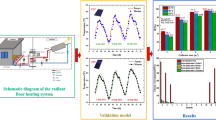Abstract
The thermal performance enhancement of the hydronic radiant floor heating system by tube shape refinements is investigated in this paper. Both analytical and detailed numerical modelings are carried out to predict the performance of the radiant system. While the simple analytical model briefly investigates the possibility of the effect of the tube shape improvement with the parametric analysis, the commercial computational fluid dynamics (CFD) code (Ansys/CFX) is used to perform the detailed 3D analysis under different tube shape conditions. The fin thickness, the number of fins, and the tube thermal conductivity turn out to have significant effects on the radiant system performance. The potential energy saving impacts of the tube shape refinements are also discussed. The tube shape improvement turns out to increase the floor surface temperature and to decrease the hot water temperature drop across the system, resulting in heating energy savings.
Similar content being viewed by others
References
Ahn, B.C., Sone, J.Y., Lee, T.W., Kim, Y.K., 2006. Simulation and Experimental Study for Energy Flow Dynamics for Floor Radiant Heating System. Proceedings of the Society of Air-Conditioning and Refrigerating Engineers of Korea (SAREK) Summer Annual Conference, Korea.
ASHRAE, 2000. Handbook of Systems and Equipment. American Society of Heating, Refrigerating and Air-Conditioning Engineers Inc. (ASHRAE), Atlanta, USA.
Bozkir, O., Canbazoglu, S., 2004. Unsteady thermal performance analysis of a room with serial and parallel duct radiant floor heating system using hot airflow. Energy and Buildings, 36(6):579–586. [doi:10.1016/j.enbuild.2004.01.039]
Chen, T.Y., 2002. Application of adaptive predictive control to a floor heating system with a large thermal lag. Energy and Buildings, 34(1):45–51. [doi:10.1016/S0378-7788 (01)00076-7]
Cho, S.H., Zaheer-Uddin, M., 1999. An experimental study of multiple parameter switching control for radiant floor heating systems. Energy, 24(5):433–444. [doi:10.1016/S0360-5442(98)00101-7]
Incropera, F.P., Dewitt, D.P., Bergman, T.L., Lavine, A.S., 2006. Fundamental of Heat and Mass Transfer (6th Ed.). John Wiley & Sons Inc., Hoboken, USA.
Kilkis, B., Eltez, M., Sager, S., 1995. A simplified model for the design of radiant in-slab heating panels. ASHRAE Transactions, 99(2):210–216.
Laouadi, A., 2004. Development of a radiant heating and cooling model for building energy simulation software. Building and Environment, 39(4):421–431. [doi:10.1016/j.buildenv.2003.09.016]
Sattari, S., Farhanieh, B., 2006. A parametric study on radiant floor heating system performance. Renewable Energy, 31(10):1617–1626. [doi:10.1016/j.renene.2005.09.009]
Author information
Authors and Affiliations
Corresponding author
Rights and permissions
About this article
Cite this article
Chae, Y.T., Lee, K.H. & Park, J.S. Improved thermal performance of a hydronic radiant panel heating system by the optimization of tube shapes. J. Zhejiang Univ. Sci. A 12, 428–437 (2011). https://doi.org/10.1631/jzus.A1000358
Received:
Accepted:
Published:
Issue Date:
DOI: https://doi.org/10.1631/jzus.A1000358




